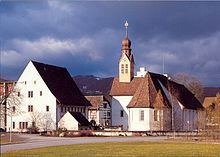 | ||
Tänikon monastery is a former Cistercian monastery in the village of Ettenhausen in the municipality of Aadorf in the canton of Thurgau in Switzerland. The former monastery church and the monastery buildings, now Agrotechnorama Tänikon, are both Swiss heritage site of national significance.
History
Tänikon was first mentioned in 789 as Tanninchova as a local court. In 817 emperor Louis the Pious gave all his lands in Thurgau, including Tänikon, to the Abbey of St. Gall. An established nunnery at Tänikon was first mentioned in 1249. In 1257, the monastery church took over the rights to the nearby chapel of St. Anna. Around the same time Eberhard II and Eberhard III of Bichelsee granted land holdings to the monastery and it became a Cistercian monastery. In 1263, Pope Urban IV asked the abbot of Kappel, to administer Tänikon. Beginning in 1268 the monastery had a number of lay brothers who lived and worked in the monastery. They were slowly replaced by secular servants or employees and in 1491 there were no more lay brothers. In 1415 the Hohenlandenberg and Gachnang families donated money to help establish a parish benefice for the monastery chapel. By 1520, the monastery owned land or rights in Aadorf, Bichelsee, Elgg, Ellikon, Ettenhausen Gerlikon, Guntershausen, Hagenbuch, Krillberg, Lommis, Niederwil, Stettfurt, Tannegg and Tuttwil. In 1508 Abbess Anna Welter of Blidegg built a new refectory on the grounds.
During the Protestant Reformation in 1523 several nuns left the monastery. When the Protestant Council of Zurich visited in 1525, there were still 13 nuns at the monastery. A few years later, in 1532, the abbess retired though a few sisters remained. Sophia of Grüth was appointed caretaker over the monastery in 1548. Two years later she was raised to be the abbess and the Abbot of Wettingen was appointed as the monastery's Visitor. It became a center of the Counter Reformation and in 1606 all nuns were required to strictly obey the rules of the order. During the 17th century, the monastery grew and several new buildings were built, including the prelate's house in 1616 and the abbess' house in 1678. During the wave of secularization that followed the Helvetic Republic, much of the monastery's land was nationalized. After 1804, they were virtually forbidden to accept any new novitiates. The Thurgau Cantonal Constitution of 1831 placed all the monastery's assets under state control. In 1836, the canton appointed a trustee and sold the monastery lands. In 1848 the Grand Council of Thurgau dissolved the monastery and took over the buildings. Two years later, 1850, they sold the monastery and chapel to the Planta family and the Tänikon parish church. In 1853, the nuns moved into the former Capuchin monastery at Frauenfeld. In 1869 they moved again to Mariastern Abbey in Vorarlberg in Austria. The monastery was sold in 1936 to Otto Zuber and in 1969 it was taken over by the new Eidgenosenschaft Forschungsanstalt für Betriebswirtschaft und Landtechnik (Swiss Federal Institute of Business and Agriculture). In 2006 it became the Agrotechnorama Tänikon.
During the 15th and 16th centuries, portions of the monastery were demolished and later a road was built through the cloister. The former monastery church includes a marble pulpit and altar by Johann Josef Mosbrugger from 1830-31.
